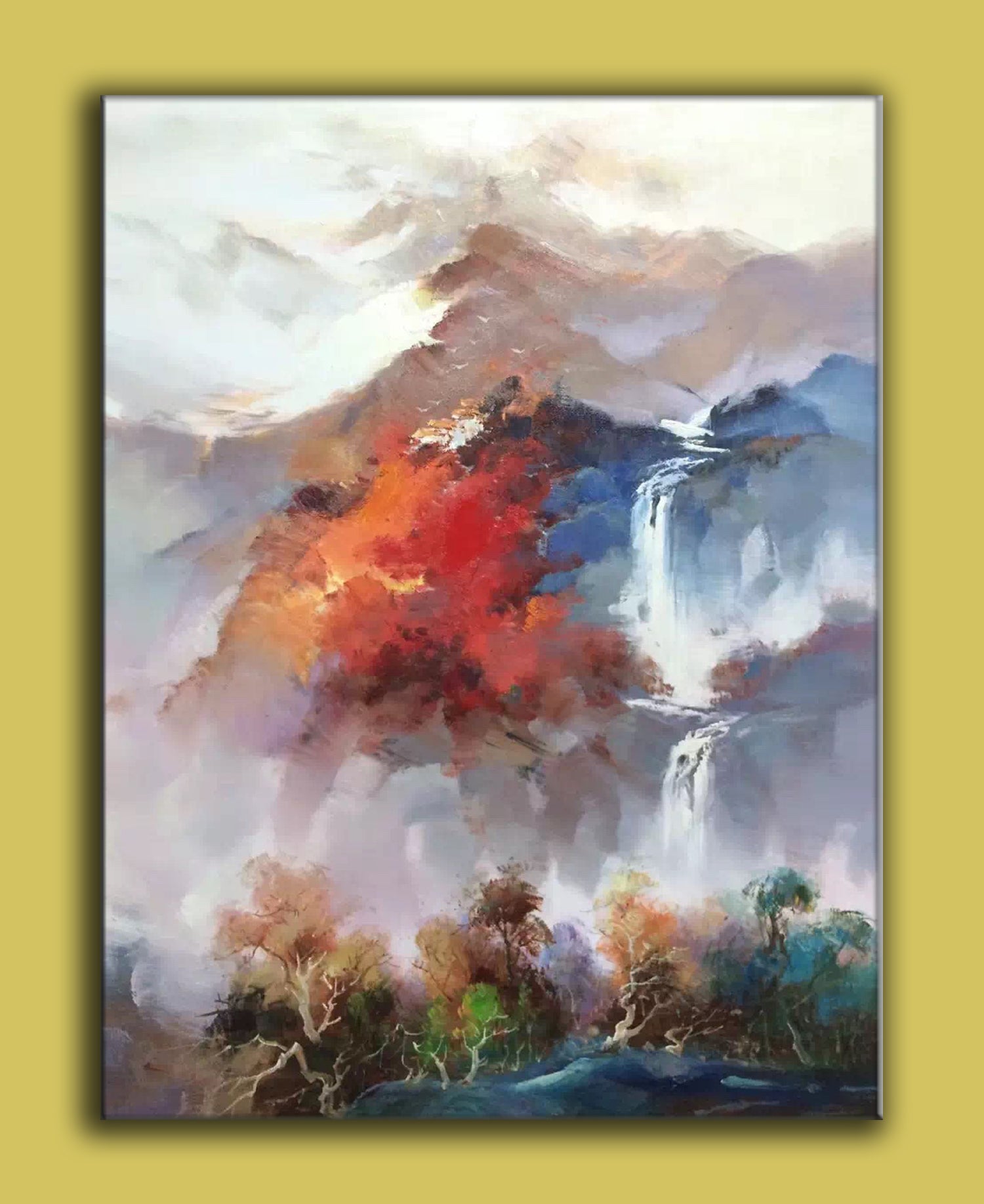Frequently Refreshed Collection of Oil Paintings for Sale
Frequently Refreshed Collection of Oil Paintings for Sale
Blog Article
Checking out Everything About Oil Paints: An Overview to Comprehending Their Appeal and Value
Oil paintings have actually astounded audiences for centuries, providing a glance right into the creative mastery of numerous periods. Their abundant history is intertwined with innovative strategies and extensive emotional expression. Comprehending the materials and approaches behind these art work can improve gratitude. Additionally, the marketplace for oil paints provides opportunities for collectors and capitalists alike. As one explores this remarkable globe, the question occurs: what makes an oil painting absolutely useful?
The Background of Oil Painting: A Trip Through Time
Although oil painting has origins that go back to ancient times, it truly prospered during the Renaissance, when musicians found its adaptability and rich shade capacity. Early examples can be mapped to the 7th century, with techniques advancing significantly throughout cultures. The tool became prominent in Northern Europe in the 15th century, specifically via the jobs of artists like Jan van Eyck, that originated its use for in-depth realism and lively hues. This period noted a separation from tempera paints, permitting greater deepness and structure. As oil painting spread, it affected countless artists, bring about masterpieces by distinguished numbers such as Leonardo da Vinci and Rembrandt. The tool's legacy continues, forming the art globe well right into modern times.
Comprehending Oil Repaints: Products and Techniques
As musicians explore the globe of oil paints, they experience a diverse variety of materials and methods that define this medium. The main parts of oil paint consist of pigments, which offer color, and drying oils, such as linseed, that bind the pigments and help with application. Various additives can modify the paint's texture and drying time, improving adaptability. Strategies like glazing, where clear layers are developed, and impasto, which entails using thick paint, permit different visual effects. Additionally, using brushes, combination knives, and even fingers can create distinct textures and surfaces. Comprehending these methods and materials allows artists to fully express their imagination and attain the wanted effect in their artwork.
The Role of Color in Oil Paints
Shade plays an essential role in oil paintings, influencing both visual allure and psychological resonance. Understanding color concept essentials, consisting of the relationships in between colors, can improve an artist's capacity to communicate mood and ambience. Furthermore, mastering shade mixing strategies enables for greater deepness and richness in a paint's combination.

Color Theory Basics
Understanding shade concept is necessary for artists dealing with oil paints, as it creates the foundation for producing unified and aesthetically engaging compositions. Shade theory includes the research of just how shades communicate, the color wheel, and the partnerships in between main, secondary, and tertiary shades. Musicians utilize corresponding colors to enhance contrasts and produce centerpieces, while comparable shades promote unity and cohesiveness within a piece. Additionally, the concepts of amazing and warm shades affect the understanding of deepness and space in a paint. Understanding these concepts allows artists to adjust color properly, directing the visitor's eye and communicating their desired message. Proficiency of color concept inevitably enriches a musician's capacity to communicate emotions and ideas via their job.
Emotional Effect of Shade
The psychological impact of color in oil paints plays an essential duty in exactly how audiences attach and regard with artwork. Shades stimulate specific feelings and state of minds, affecting the audience's mood. For circumstances, cozy hues like oranges and reds can develop a sense of warmth and energy, while trendy tones such as blues and greens typically stimulate peace or self-contemplation. Artists tactically pick shade palettes to enhance narrative elements, assisting the target market's psychological trip. The saturation and comparison of colors even more enhance these impacts, attracting focus and developing focus. Inevitably, the interaction of colors in oil paintings not just boosts their visual charm but also functions as an effective medium for psychological expression, enhancing the viewer's experience and analysis.
Color Combining Techniques
While several facets of oil painting add to the total structure, understanding shade blending methods is vital for attaining desired results and depth. Color mixing can be approached via various methods, including the subtractive and additive procedures. Additive blending entails combining shades of light, while subtractive blending relies on pigments, where shades blend to create new tones. Artists frequently utilize a minimal combination to develop harmonious jobs, recognizing the relationships in between primary, second, and tertiary colors. Strategies such as glazing and scumbling even more enhance depth and luminance. By skillfully blending colors, a musician can evoke feelings, create focal points, and achieve a sense of realism, ultimately raising the paint's aesthetic and emotional impact.
Famous Oil Painters and Their Iconic Functions

Well known for their proficiency of color and method, oil painters have produced a few of one of the most well known artworks in history. Distinguished musicians like Vincent van Gogh mesmerized target markets with his stirring brushwork in "Starry Night," while Claude Monet's "Perception, Daybreak" laid the foundation for Impressionism. Leonardo da Vinci's "Mona Lisa" remains an enduring sign of creative brilliant, showcasing his skill in capturing human expression. Rembrandt's "The Night Watch" highlights his cutting-edge use of light and darkness. Other significant numbers consist of Pablo Picasso, that revolutionized modern art with his strong testing in works like "Les Demoiselles d'Avignon," and Georgia O'Keeffe, whose lively representations of landscapes and blossoms assisted specify American innovation. Each musician's special design added substantially to the oil paint landscape.
Just how to Review the Top Quality of an Oil Paint
Evaluating the quality of an oil painting involves a careful assessment of workmanship strategies, along with an evaluation of shade and structure. Observing brushwork, layering, and the application of paint can expose the artist's ability level. Additionally, the interaction of shades and the general plan of elements contribute considerably to the paint's visual value.
Evaluating Craftsmanship Techniques
A thorough evaluation of workmanship techniques is vital for determining the top quality of an oil painting. Critics should initially analyze the application of paint; thick, distinctive brushstrokes might suggest a skilled hand, while overly consistent applications can indicate a lack of deepness. oil paintings for sale. The layering method is also vital; the visibility of glazes and varied density can improve luminance and complexity. Additionally, the high quality of the products used, such as the canvas and pigments, plays a significant function in sturdiness and total visual. Interest to information in elements like sides and shifts between shades mirrors the artist's commitment to their craft. Eventually, these strategies add to the painting's emotional influence and market value, functioning as indications of the artist's skill and intent
Examining Shade and Make-up
While evaluating the quality of an oil painting, one need to concentrate on the interaction of shade and make-up, as these components are fundamental to the artwork's general impact. Color options can stimulate feelings and establish mood; therefore, the artist's scheme ought to be examined for harmony and contrast. A well-balanced structure guides the customer's eye and develops a feeling of unity. Musicians usually use strategies like the regulation of thirds or leading lines to boost aesthetic interest. Additionally, making use of light and darkness can include depth, enhancing the three-dimensionality of the paint. Inevitably, a successful oil painting marries color and make-up, involving the viewer and welcoming a deeper recognition of the artist's vision and strategy.
Caring for and Preserving Oil Paintings
Appropriate care and conservation of oil paintings is essential for maintaining their stability and durability. To secure these art work, it is essential to present them away from direct sunshine, which can cause fading and staining. Maintaining a stable setting with regulated temperature level and moisture more help in avoiding damages. Cleansing need to be done delicately making use of a soft, completely dry fabric, preventing any type of severe chemicals that might harm the paint or varnish. Regular inspections for signs of degeneration, such as flaking or breaking, are suggested. When saving or carrying oil paintings, appropriate padding and framing are necessary to prevent physical injury. Ultimately, persistent treatment contributes to the aesthetic allure and value of oil paints in time.
The Marketplace for Oil Paintings: Spending and collecting
Comprehending the marketplace characteristics for oil paints is vital for collectors and capitalists alike. The worth of these artworks is influenced by different factors, including the artist's track record, historic importance, and present fads. Collectors commonly look for pieces that resonate personally while thinking about possible recognition in worth. Auctions and galleries act as main places for trading, with prices changing based upon need and rarity. Buying oil paintings requires study right into the market, in addition to an understanding of credibility and provenance. In addition, arising musicians might offer opportunities for significant returns, while developed names can regulate high prices. Generally, a strategic method to accumulating can produce both aesthetic pleasure and monetary rewards.

Often Asked Concerns
What Are the Environmental Effects of Oil Painting Products?
The ecological influences of oil paint materials include the release of unstable organic compounds (VOCs), unsafe waste generation, and resource extraction for pigments. These elements add to air pollution and ecological destruction, increasing worries amongst ecologically aware musicians and customers.
Exactly How Do Various Canvases Impact Oil Painting Results?
Different canvases influence oil painting results considerably. Texture, absorbency, and surface quality can modify paint application, drying out times, and shade vibrancy. Musicians frequently choose certain canvases to achieve desired results and boost their creative expression.
Can Oil Paintings Be Brought Back if Damaged?
If damaged, Oil paintings can indeed be recovered. Professional conservators utilize different methods to fix rips, tidy surfaces, and address discoloration, making sure that the art work preserves its initial beauty and value for future generations.
What Are the Signs of an Original Oil Paint?
The indicators of an original oil painting include visible brush strokes, structure variants, and an here irregular canvas weave (oil paintings for sale). In addition, credibility might be validated via provenance, trademarks, and the visibility of a varnish layer unique to oil tools
How Has Innovation Influenced Modern Oil Painting Techniques?
Innovation has significantly influenced modern oil painting strategies by presenting electronic devices for planning, improved materials for texture and longevity, and on the internet platforms for marketing and sharing art, therefore expanding musicians' innovative possibilities and audience reach. Oil painting has roots that date back to old times, it truly flourished during the Renaissance, when artists discovered its versatility and rich shade potential. The psychological impact of color in oil paints plays a critical role in just how audiences link and perceive with artwork. While lots of aspects of oil painting contribute to the general make-up, mastering color mixing strategies is important for accomplishing wanted results and depth. Assessing the top quality of an oil paint involves a careful assessment of craftsmanship methods, as well as an evaluation of shade and make-up. While reviewing the quality of an oil painting, one must focus on the interplay of color and composition, as these aspects are essential to the art work's general influence.
Report this page